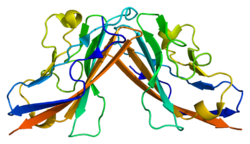Cardiac
CAR is essential for normal development of cardiomyocytes. The expression of CAR is high in developing tissues, including the heart and brain; postnatally it is expressed in epithelial cells and in adult cardiac muscle, it is localized at intercalated discs. [15] Knocking out CAR is embryonic lethal in mice by day 11.5, coordinate with severe cardiac muscle abnormalities including left ventricular hyperplasia, sinuatrial valve abnormalities, pericardial edema, thoracic hemorrhaging, myocardial wall degeneration, regional apoptosis, reduced density and disorganization of myofibrils, and enlarged mitochondria. [16] [17] [18] Cardiomyocyte-specific deletion of CAR after embryonic day 11 had no noticeable effect on development and postnatal life, suggesting that CAR is critical during a temporal window of cardiac development. [18]
It is clear from studies employing transgenesis that CAR function at intercalated discs in cardiac muscle is critical for normal heart function. Cardiac-specific knockout of CAR causes first degree block or complete block in the propagation of electrical conduction in the AV node. This was coordinate with the loss of connexin-45 at cell-cell junctions on the sarcolemmal membranes of AV node cells. Mice eventually developed cardiomyopathy associated with intercalated disc disorganization and loss of cardiomyocyte beta-catenin and ZO-1 expression; studies also showed that CAR, and connexin-45 form a protein complex that requires the PDZ-binding motif on CAR for proper formation. Moreover, CAR is required for normal localization of connexin-45, beta-catenin and ZO-1 at intercalated discs. [19]
Studies from human hearts have shown that lower expression of CXADR mRNA is associated with a risk allele at chromosome 21q21, which may in fact predispose hearts to arrhythmias. To discern the mechanistic underpinnings, hearts from heterozygous CAR knockout mice subjected to acute myocardial ischemia were evaluated and showed slowed ventricular conduction, earlier onset of ventricular arrhythmias, and increased susceptibility to arrhythmias. These findings were coordinate with a reduction in magnitude of the sodium current at intercalated discs; CAR coprecipitated with NaV1.5, which may provide a mechanistic link to this finding. [20]














